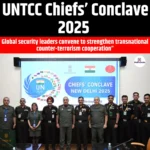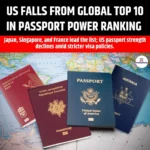|
GS Paper III: Defence, Various Security Forces and Agencies and Their Mandates |
Director General of Military Operations (DGMO)
Why in News?
Recently, after India’s strong military action in “Operation Sindoor”, Pakistan offered a ceasefire proposal. Following this, a dialogue was held at the DGMO level between the two countries.
- On the Indian side, DGMO – Lieutenant General Rajiv Ghai participated in the talks, while on the Pakistani side, DGMO – Major General Kashif Abdullah Chaudhry represented Pakistan.
Director General of Military Operations (DGMO): Meaning and Role
- This role is considered extremely important as a chief strategist during both war and peace.
- This post is given to a senior officer of the Lieutenant General (three-star) rank.
- He is responsible for planning and monitoring all operational decisions of the Indian Army.
- The DGMO office is located at the Army Headquarters in South Block, New Delhi.
- The main objective of the DGMO is to plan war operations and ensure coordination among different wings of the Army.
- Joint operations of the Army, Navy, and Air Force are streamlined by the DGMO.
- Whenever there is tension on India’s borders, the DGMO is the first to collect information and analyze the situation.
- He directly reports to the Chief of Army Staff (COAS) and coordinates with the Ministry of Defence and the Prime Minister’s Office, if required.
- The DGMO maintains direct military communication with Pakistan through regular weekly hotline exchanges.
- The DGMO is not just an administrative role. It is a combination of battle expertise, diplomatic understanding, and quick decision-making, which is central to a nation’s military strength.
Key Duties and Responsibilities of the DGMO
- Execution of Military Operations:
- The DGMO is responsible for designing, directing, and monitoring all operations across the country.
- From counter-terrorism to emergency war responses, strategic leadership is in the DGMO’s hands.
- He also checks the Army’s operational readiness and oversees training exercises.
- Diplomatic Military Dialogue:
- In times of border tension with countries like Pakistan or China, the DGMO maintains communication through hotline talks with military counterparts.
- He ensures that the situation remains under control and any ceasefire violations are responded to strategically.
- Tri-Services Coordination:
- The DGMO is not limited to the Army. He coordinates with the Air Force and Navy to execute integrated and strategic military missions.
- He also stays in touch with the National Security Advisor (NSA), Ministry of Defence, and other agencies to create an integrated national security approach.
- Restructuring Military Strategy:
- Even during peace, the DGMO leads deployment planning, logistics, and integration of new military technologies and doctrines.
- Special Role on the LOC and Disputed Areas:
- When tensions rise on the Line of Control (LOC), the DGMO plans military responses and works to restore peace.
- In 2025, after “Operation Sindoor”, the DGMO held talks with Pakistan’s DGMO to help de-escalate the situation.
DGMO Selection and Salary
- Selection:
- There is no open exam or general recruitment process for this post.
- The DGMO is appointed through a collaborative decision by the Army Chief and the Defence Ministry.
- Officers chosen for DGMO are usually those who have commanded key military units like Northern Command, Corps Commands, or worked at Army Headquarters.
- They must have studied at top institutions like the National Defence Academy (NDA), Indian Military Academy (IMA), or National Defence College (NDC).
- Long operational and administrative experience is also essential.
- Salary:
- As per the 7th Pay Commission, a Lieutenant General serving as DGMO earns a basic salary between ₹1,82,200 and ₹2,24,100 per month.
- In addition, they receive strategic allowances, defence allowances, risk pay, housing, official vehicles, medical care, and special security benefits.
- Altogether, the total salary package ranges from ₹2.5 lakh to ₹3 lakh per month.
Establishment and Historical Evolution of DGMO
- The DGMO role was introduced as a pivotal shift to enhance operational command within the Indian Army’s hierarchy.
- Its formal strengthening took place after the 1965 India-Pakistan war.
- During this war, due to a lack of operational coordination, it was realized that a high-ranking officer was needed to plan and direct all military operations.
- From 1947 to 1970, India’s security policy had scattered military operations on many fronts.
- With time, while facing external threats (especially from Pakistan and China), the post of DGMO was created and assigned to an officer of the Lieutenant General rank.
- In the 1971 India-Pakistan war, the DGMO played a very important role.
- Planning the war, building military pressure on the Line of Control (LoC), and India’s intervention in the Bangladesh Liberation War — all these decisions were based on the DGMO’s military strategies.
- From the 1980s to the 2000s, when insurgency in Kashmir and Pakistan-sponsored terrorism were at their peak, the DGMO provided decisive leadership in quick border responses, intelligence coordination, and operational command.
- After 2000, when India adopted military modernization and network-centric warfare, the DGMO’s role was equipped with technical and digital capabilities.
- In events like the 2016 surgical strike and the 2021 ceasefire agreement, the DGMO not only gave operational leadership but also played a key role in public communication and diplomatic dialogue.
Current DGMO of India
- Lieutenant General Rajiv Ghai is the current DGMO of the Indian Army.
- He took over this important responsibility on 25 October 2024, and since then, he has been guiding the operational policies and strategies of the Indian Army.
- Rajiv Ghai’s military journey began at the Indian Military Academy (IMA), Dehradun, where he received military training and was commissioned into the Kumaon Regiment in December 1989.
- Prior to his DGMO role, Lieutenant General Ghai held several significant military leadership positions.
- He led successful counter-terrorism missions in the sensitive areas of Jammu and Kashmir.
- He served as the General Officer Commanding (GOC) of the Chinar Corps (15 Corps) in Srinagar for about one and a half years.
There, he played a key role in ensuring the security of the LoC and in dismantling the active terrorist network in the valley.









